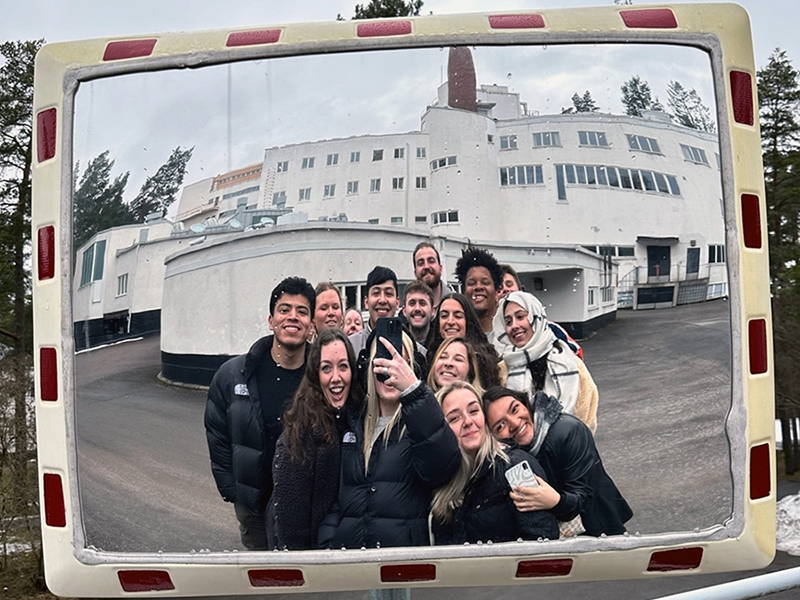
A group of Fay Jones School of Architecture and Design students recently visited Helsinki, Finland, as part of their spring semester design studio. "Exhibit A + D," an advanced studio led by Dean Peter MacKeith and in collaboration with Studio Gang, a nationally recognized Chicago-based practice, examined what a contemporary museum of architecture and design looks like in Finland, a nation known for its deep design culture and its commitment to building in timber and wood.
"There is a deepening relationship between Finland and the United States, especially in light of Finland's recent admission into NATO, but particularly in the research areas of clean energy, forestry and wood product development, telecommunications and data sciences, and in arts and culture exchanges," MacKeith said. "This swift immersion into Finland and into its capital city was clearly stimulating and educational, but also transformative to the students' understanding of a rich architecture and design culture now committed to being a 'green super-power.'"
The advanced design studio acted as a test pilot for a proposed museum on an established site in Helsinki. The goal of the real-world project is to build the world's leading museum of architecture and design in Finland. Both the city of Helsinki and the state of Finland have conditionally committed to backing the new museum, and a design competition will be organized once a decision to build the museum has been reached.
Before traveling to Finland, the studio completed in-depth research on the country. Hannah Eslick, a fifth-year interior architecture and design student from Austin, said those exercises allowed them to enter the visit with knowledge of both the country and the site-specific area for the project. It also helped deconstruct any preconceived ideas students may have had of Finland.
Fifth-year architecture student Nayelli Garcia said it was surreal to experience the culture after spending weeks researching and building a site model of Helsinki. Their model measured 6 feet by 10 feet, although it was constructed at a metric scale.
"The urban fabric, language and usage of materials in a different climate than Arkansas was a new experience and understanding," said Garcia, who's from Springdale.
But even after having studied the area, Garcia found that visiting in person held some unknowns.
"Though public transportation was easily accessible, I was surprised how quick and simple their system is compared to other cities like Rome or New York," Garcia said. "I was able to explore much of the city center within minutes and get to the harbor at a turn of a corner."
Mark Johnson, a fifth-year architecture student from Shreveport, Louisiana, agreed, saying the weeks spent researching and building a site model put their visit in perspective. The experience also shifted Johnson's long-term design approach.
"This was the first studio trip that truly opened my eyes to the entire concept of architecture," Johnson said. "I have never noticed the amount of detail that goes into every little piece of a project."
As Helsinki and the nation of Finland are committed to being carbon neutral by 2030, the guiding principles in building, planning and programming the new museum are based on environmental, cultural and social sustainability. The studio mirrored what the design process for that museum could look like, helping students to approach design issues realistically.
For the studio, students developed plans for a new 100,000-square-foot proposed museum building in Helsinki's historic seafront, in the South Harbor's Makasiinirata district. The museum would be in the city center, near the Market Square, the Old Market Hall and the re-developed Makasiinirata area. The proposed center would house state-of-the-art exhibitions and forward-looking programs, merging the Museum of Finnish Architecture and the Design Museum into one.
As students returned to Arkansas, they emphasized how their experience in Helsinki shaped their design perspective.
"It encouraged me to pay closer attention to users of a building, allowing the social spatial to be fluid throughout the building and considering the building lifespan after years of usage," Garcia said. "These were moments I keep in my design."
Eslick said the shift could be seen by the first studio review after the trip, just days after they returned.
"Being able to meet with the people, see the city and actually experience the atmosphere and culture of Finland was the most helpful part of our learning and design development," Eslick said. "It's one thing to be given a site with the expectation of researching its surroundings, but it doesn't compare to how much you can learn whilst physically visiting the site, especially if it's in a foreign country."
While in Helsinki, the group visited local museums, toured Alvar Aalto's masterwork, the Villa Mairea in Noormarkku, and the Alvar Aalto House and Studio, met with local architects and visited the U.S. Embassy in Finland and the Finnish Ministry of Foreign Affairs.
The studio focused on museum typology, contemporary exhibition strategies and public engagement, sustainable carbon-neutral design, design and construction in timber and wood, and the collaborative design process.
Before traveling to Finland, the studio took a working field trip to Studio Gang's Chicago office, working alongside their designers and taking advantage of the entire breadth and depth of the practice's staff, approach, expertise and experience.
Led by founding principal Jeanne Gang, Studio Gang is a highly collaborative, multidisciplinary practice with a range of designers, technical experts and allied consultants. The firm recently completed the redesign of the 133,000-square-foot Arkansas Museum of Fine Arts in Little Rock.
Throughout the semester, members of Studio Gang joined the design studio weekly in person and virtually for lectures, critiques and reviews.
A partial travel subsidy was provided by the Fay Jones School through a specially designated gift fund for education in timber and wood design.
For more images from the students’ Finland trip, visit the Fay Jones School’s Instagram.
Topics
Contacts
Tara Ferkel, communications specialist
Fay Jones School of Architecture and Design
479-575-4704, tferkel@uark.edu
Michelle Parks, director of communications
Fay Jones School of Architecture and Design
479-575-4704, mparks17@uark.edu